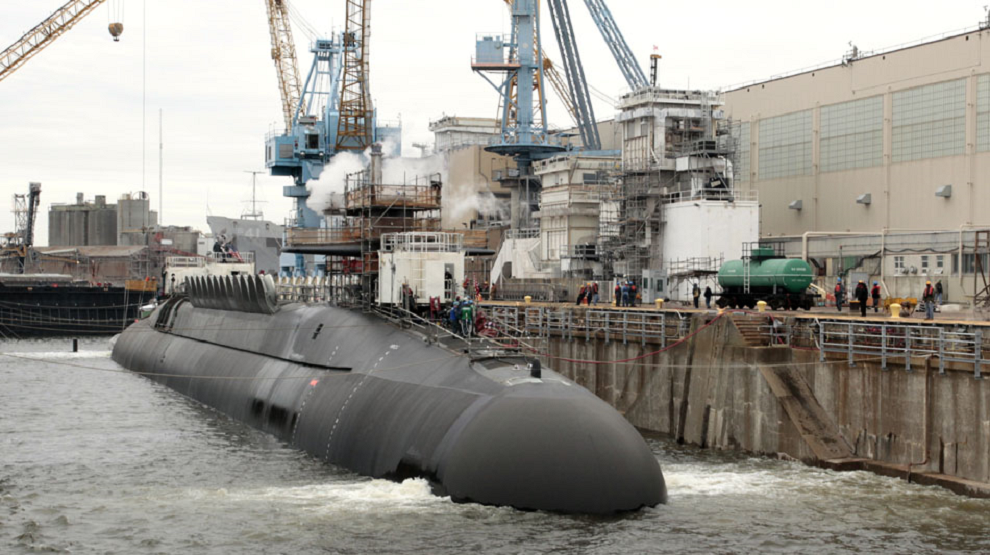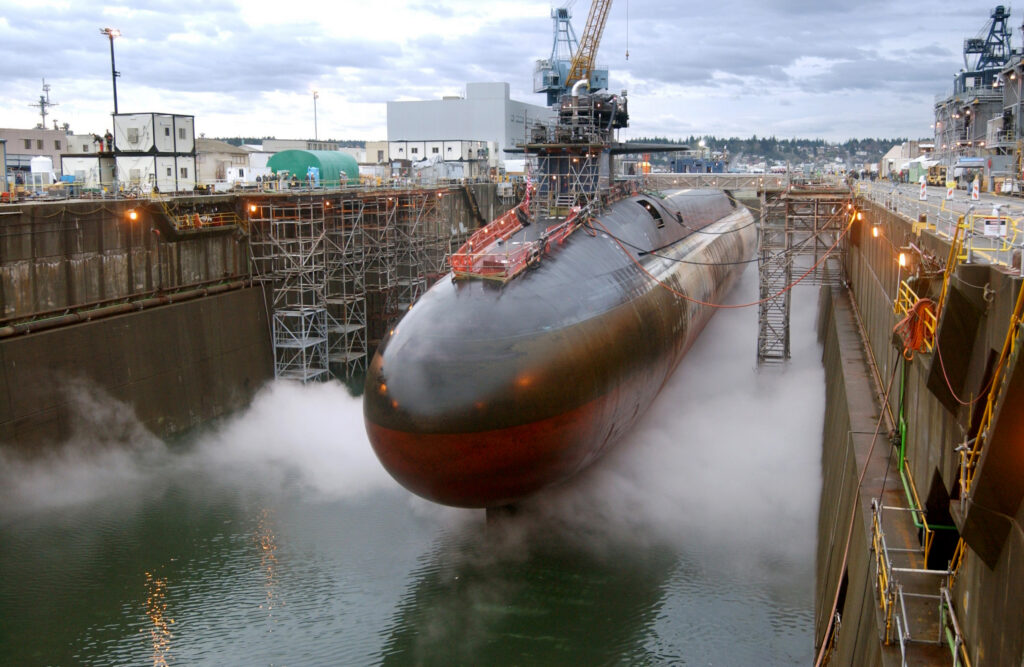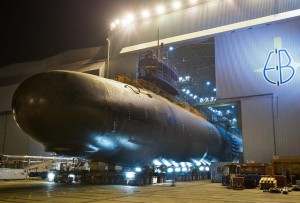Submarine Maintenance Backlog Threatens Crisis Response: Admiral
Posted on

A submarine undergoes maintenance at the government-owned Norfolk Naval Shipyard.
CRYSTAL CITY: The good news? The US submarine fleet is meeting day-to-day demands around the world, without having to do the extra-long deployments that have ground down surface ships and sailors. The bad news? A massive maintenance backlog that could idle 15 submarines for months – costing an estimated seven to 15 years of time at sea – means fewer subs would be ready to reinforce forward-deployed forces in a crisis.
“If you have a submarine that’s tied up in the shipyard, then obviously they’re not operating,” Vice Adm. Joseph Tofalo told me. “It’s probably most manifest in our ability to surge in time of crisis. We meet our combatant commander (COCOM) demand on a day to day basis, but the impact would be, if there’s a crisis, then your surge tank is low.”
Tofalo and other officers at last week’s Naval Submarine League conference made clear they’re laboring mightily to make up for the shortfall. The Navy wants to build more new Virginia-class submarines, and faster, while extending the service lives of the Virginia and Los Angeles boats it already has. It is adjusting work schedules and outsourcing “about a million man-hours of work…over five years” from maxed-out government-owned yards to private shipyards Newport News and Electric Boat, Tofalo said. (Many in Congress would like it to outsource more). As Commander, Submarine Forces, Tofalo has also streamlined the training schedule to concentrate on the most challenging missions, especially the kind of high-intensity warfare against an advanced adversary that a crisis might require.

USS Ohio being converted from a ballistic missile (SSBN) to a cruise missile (SSGN) submarine.
Submarine Readiness
It’s also worth noting that submarine readiness has never been stretched as badly as in the surface force, which has suffered from a vicious cycle: hard-used ships need extra time in maintenance and thus miss their deployment dates, forcing other ships to stay at sea longer to cover the gap, which means those ships will need unplanned maintenance and deploy late in turn. The worst cases occurred in the Japan-based 7th Fleet, where two destroyers collided with civilian ships this summer, killing 17.

Rear Adm. Joseph Tofalo
By contrast, submarine deployments have averaged 182 days over the last three years. That almost perfectly tracks the official norm of six months overseas and 12 months doing maintenance and training at home. In fact, deployment timelines have trended downward lately.
There are exceptions: The USS Jacksonville recently did eight months on its final tour before retiring. “The real world gets a vote, and so that causes, episodically, things to happen,” Tofalo said. “Can you put a pattern to what Kim Jong-un is going to do? What China’s going to do or Russia, Iran?”
But overall, Tofalo said, sub deployment cycles are “fairly stable.” They have to be, he told me, because submarines operate on 18-month cycle, while most surface ships are on a 36-month one. There’s no room in the tighter sub cycle to accommodate delays.

USS New Mexico
While there have been few delays due to over-long deployments, however, there have been delays due to over-long maintenance periods. Over the last eight years, Tofalo told the conference, six submarines “have taken or are projected to take 50 percent to 100 percent longer to complete their overhauls than expected.” The current backlog affects 15 submarines and could cost the Navy almost 15 years of time at sea, although there’s a mitigation plan in place to halve that.
What’s going wrong? “This is a long term issue,” Tofalo told me. “It started back in the nineties.” The Navy cut back from eight public shipyards to four. Then it increased the shipyard workload by converting four Ohio-class ballistic missile submarines (SSBNs) to Tomahawk cruise missile carriers (SSGNs). Then it increased the workload again by deciding to overhaul the Ohios to keep them in service longer, which allowed more time to develop the $128 billion replacement program, the Columbia class. Older, more efficient workers retired en masse, forcing the yards to hire and train a new generation.

Vice Adm. James Caldwell
Meanwhile budget caps, sequestration cuts, continuing resolutions, government shutdowns, and hiring freezes made it harder to get work done. “It’s this perfect storm of a lot of stuff over two decades, and then you throw on top of it sequestration, the Budget Control Act and the unpredictability of funding,” Tofalo said.
“We’ve had a backlog of maintenance that started with sequestration,” echoed Adm. James Caldwell, head of Naval Reactors (NR). “We’ve got a very young and inexperienced work force in the yards… roughly 50 percent is under five years of experience. We’ve also had emerging work” (i.e. unplanned extra maintenance).
So, Caldwell continued, “we sharpened our pencils and looked at schedules and made those work better for us, and actually we’ve substantially reduced the months of backlog” from 177 (14.75 years) to 81 (6.75 years). “We are hiring in the shipyards (with) very aggressive training plan,” he said. “We’ve had to change our paradigm….We don’t have years and years to develop a mechanic.”

The Virginia-class attack submarine USS North Dakota.
Build More Boats & Keep ‘Em Longer
The Navy is also looking at extending the lives of at least some of its aging Los Angeles attack subs. As each boat approaches its planned retirement date, said Rear Adm. Michael Jabaley, Program Executive Officer for Submarines, it is subjected to an in-depth study to see if it can do one more deployment.
The Navy is also reexamining whether its newer Virginia-class submarines need as much time-consuming major maintenance as originally estimated. “Based on engineering analysis and actual data coming back off the first ships of class,” Jabaley said, the Navy is studying “instead of having four major maintenance periods throughout the life of the ship, you would have only three.”

Adm. David Johnson
Besides easing the burden on the shipyards, getting rid of one major maintenance “availability” per Virginia would allow each submarine to do one additional deployment in its career, going from 14 to 15. To get the same increase in overseas presence by building more submarines would require increasing production by seven percent.
The service and shipyards have also sped up construction of new Virginias, with the time to build a sub dropping from seven years (84 months) for the first in the class to a projected five years (60 months) for some future boats.
Most crucially, said the Navy’s top uniformed acquisition official, Vice Adm. David Johnson, the shipyards need to keep pumping out new Virginia attack subs at a rate of two a year – even in years they also have to build a much bigger Columbia ballistic missile boat. The original plan was to alternate: in some years the yards would build two Virginias, in others one Virginia and one Columbia. Now the Navy says the yards can and must ramp up to keep the attack subs coming like clockwork to build the fleet of 66 – up from 52 today – that the Navy says it needs.
“We really do need to keep it two a year. That’s a machine,” Johnson said. ” “if you want to have 66 submarines, you build them at two a year with a 33-year life.”
An earlier version of this story incorrectly stated the Jacksonville has spent 18 months deployed; the correct figure is eight.
Subscribe to our newsletter
Promotions, new products and sales. Directly to your inbox.
